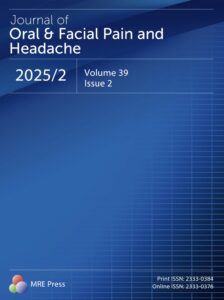Publications

Evaluating the reliability of myotonometry for assessing masseter muscle hypertrophy in healthy subjects
Authors: Malgorzata Galczynska-Rusin 1, Malgorzata Pobudek-Radzikowska 1, Zofia Maciejewska-Szaniec 1, Agnieszka Przystanska 2, Agata Czajka-Jakubowska 1
Affiliations:
- Department of Orthodontics and Temporomandibular Disorders, Poznan University of Medical Sciences, 60-812 Poznan, Poland
- Department of Anatomy, Poznan University of Medical Sciences, 60-781 Poznan, Poland
Journal: Journal of Oral & Facial Pain and Headache - June 2025, Volume 39, Issue 2, Pages 175-182 (DOI: 10.22514/jofph.2025.036)
-
Field & Applications:
- Medical
- Orofacial muscles
- Musculoskeletal disorder
- Musculoskeletal health
- Reliability
- Validity
Background: Masseter muscle hypertrophy is characterized by either symmetrical or asymmetrical enlargement of the muscle, often associated with bruxism and other parafunctional habits. Traditional methods for assessing muscle hypertrophy, such as palpation and visual inspection, can be subjective and heavily dependent on the clinician’s experience. In contrast, devices like MyotonPRO offer a standardized, objective and reproducible approach, enhancing the precision and reliability of clinical diagnostics. The primary aim of our study was to evaluate the intra- and inter-rater reliability of the MyotonPRO device in assessing the viscoelastic properties of the masseter muscle. Additionally, we sought to investigate the potential correlation between subjective assessments of masseter hypertrophy and objective measurements obtained through myotonometry.
Methods: A clinical examination using muscle palpation was conducted to identify masseter hypertrophy, categorizing participants into Normal Muscle Volume (NMV) and Muscle Hypertrophy (MH) groups. The viscoelastic properties of their masseter muscles were then measured using MyotonPRO in both relaxed and maximal contraction states. Two experienced operators performed the myotonometry on the same day, with the first operator repeating the procedure 7 days later.
Results: Among the 58 participants, 51.7% were female, with a mean age of 28.6 years. The inter-rater reliability of masseter muscle measurements using MyotonPRO ranged from moderate to excellent, both at rest and during contraction, while intra-rater reliability ranged from moderate to good. The MH group showed higher levels of tension and stiffness, along with reduced relaxation time and creep during contraction, compared to the NMV group. The only statistically significant difference in relaxation between the groups was observed in muscle elasticity.
Conclusions: The MyotonPRO device effectively detects statistically significant differences (p < 0.05) between the MH and NMV groups for certain viscoelastic parameters. However, these differences were primarily significant during contraction, with elasticity being the only parameter showing a significant difference in the relaxed state.
Keywords: masseter hypertrophy, myotonometry, reliability
The MyotonPRO device is a reliable tool for detecting a statistically significant difference (p < 0.05) between the MH and an NMV group for certain viscoelastic parameters. However, these differences were predominantly significant for most parameters in contraction, with elasticity being the only parameter that showed a significant difference in the relaxed state. To the authors’ knowledge, this is the first study to examine the discriminant validity of the Myoton myotonometer by investigating the masseter muscle in different states.


